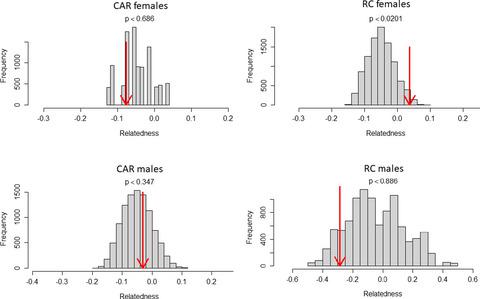当前位置:
X-MOL 学术
›
Ecol. Evol.
›
论文详情
Our official English website, www.x-mol.net, welcomes your
feedback! (Note: you will need to create a separate account there.)
No evidence for female kin association, indications for extragroup paternity, and sex-biased dispersal patterns in wild western gorillas
Ecology and Evolution ( IF 2.3 ) Pub Date : 2021-05-25 , DOI: 10.1002/ece3.7596 Shelly Masi 1 , Frédéric Austerlitz 1 , Chloé Chabaud 1, 2 , Sophie Lafosse 1 , Nina Marchi 1, 3 , Myriam Georges 1, 4 , Françoise Dessarps-Freichey 1 , Silvia Miglietta 1 , Andrea Sotto-Mayor 1 , Aurore San Galli 1 , Ellen Meulman 1 , Emmanuelle Pouydebat 5 , Sabrina Krief 1 , Angelique Todd 6, 7 , Terence Fuh 6 , Thomas Breuer 8, 9 , Laure Ségurel 1, 10
Ecology and Evolution ( IF 2.3 ) Pub Date : 2021-05-25 , DOI: 10.1002/ece3.7596 Shelly Masi 1 , Frédéric Austerlitz 1 , Chloé Chabaud 1, 2 , Sophie Lafosse 1 , Nina Marchi 1, 3 , Myriam Georges 1, 4 , Françoise Dessarps-Freichey 1 , Silvia Miglietta 1 , Andrea Sotto-Mayor 1 , Aurore San Galli 1 , Ellen Meulman 1 , Emmanuelle Pouydebat 5 , Sabrina Krief 1 , Angelique Todd 6, 7 , Terence Fuh 6 , Thomas Breuer 8, 9 , Laure Ségurel 1, 10
Affiliation

|
Characterizing animal dispersal patterns and the rational behind individuals’ transfer choices is a long-standing question of interest in evolutionary biology. In wild western gorillas (Gorilla gorilla), a one-male polygynous species, previous genetic findings suggested that, when dispersing, females might favor groups with female kin to promote cooperation, resulting in higher-than-expected within-group female relatedness. The extent of male dispersal remains unclear with studies showing conflicting results. To investigate male and female dispersal patterns and extragroup paternity, we analyzed long-term field observations, including female spatial proximity data, together with genetic data (10 autosomal microsatellites) on individuals from a unique set of four habituated western gorilla groups, and four additional extragroup males (49 individuals in total). The majority of offspring (25 of 27) were sired by the group male. For two offspring, evidence for extragroup paternity was found. Contrarily to previous findings, adult females were not significantly more related within groups than across groups. Consistently, adult female relatedness within groups did not correlate with their spatial proximity inferred from behavioral data. Adult females were similarly related to adult males from their group than from other groups. Using RST statistics, we found significant genetic structure and a pattern of isolation by distance, indicating limited dispersal in this species. Comparing relatedness among females and among males revealed that males disperse farer than females, as expected in a polygamous species. Our study on habituated western gorillas shed light on the dispersal dynamics and reproductive behavior of this polygynous species and challenge some of the previous results based on unhabituated groups.
中文翻译:

没有证据表明野生西部大猩猩存在女性亲属关系、群体外亲子关系以及性别偏见的扩散模式
表征动物扩散模式和个体转移选择背后的理性是进化生物学中长期存在的一个令人感兴趣的问题。在野生西部大猩猩(大猩猩)这种一雄一夫多妻的物种中,先前的基因发现表明,在分散时,雌性可能会偏爱有雌性亲属的群体以促进合作,从而导致群体内雌性相关性高于预期。雄性扩散的程度仍不清楚,研究结果相互矛盾。为了研究雄性和雌性扩散模式和群外亲子关系,我们分析了长期实地观察,包括雌性空间邻近数据,以及来自一组独特的四个习惯性西部大猩猩群体和另外四个个体的遗传数据(10个常染色体微卫星)。群外雄性(总共 49 个体)。大多数后代(27 只中的 25 只)都是由雄性群体所生。对于两个后代,发现了群体外亲子关系的证据。与之前的研究结果相反,成年女性在群体内的相关性并不比群体间的相关性显着更高。一致的是,群体内成年女性的相关性与从行为数据推断出的空间接近度并不相关。与其他群体相比,该群体的成年女性与成年男性的关系相似。使用R ST统计数据,我们发现了显着的遗传结构和距离隔离的模式,表明该物种的传播有限。比较雌性和雄性之间的相关性表明,雄性比雌性分散得更远,正如在一夫多妻制物种中所预期的那样。 我们对习惯性西部大猩猩的研究揭示了这种一夫多妻制物种的扩散动态和繁殖行为,并对之前基于不习惯群体的一些结果提出了挑战。
更新日期:2021-06-22
中文翻译:

没有证据表明野生西部大猩猩存在女性亲属关系、群体外亲子关系以及性别偏见的扩散模式
表征动物扩散模式和个体转移选择背后的理性是进化生物学中长期存在的一个令人感兴趣的问题。在野生西部大猩猩(大猩猩)这种一雄一夫多妻的物种中,先前的基因发现表明,在分散时,雌性可能会偏爱有雌性亲属的群体以促进合作,从而导致群体内雌性相关性高于预期。雄性扩散的程度仍不清楚,研究结果相互矛盾。为了研究雄性和雌性扩散模式和群外亲子关系,我们分析了长期实地观察,包括雌性空间邻近数据,以及来自一组独特的四个习惯性西部大猩猩群体和另外四个个体的遗传数据(10个常染色体微卫星)。群外雄性(总共 49 个体)。大多数后代(27 只中的 25 只)都是由雄性群体所生。对于两个后代,发现了群体外亲子关系的证据。与之前的研究结果相反,成年女性在群体内的相关性并不比群体间的相关性显着更高。一致的是,群体内成年女性的相关性与从行为数据推断出的空间接近度并不相关。与其他群体相比,该群体的成年女性与成年男性的关系相似。使用R ST统计数据,我们发现了显着的遗传结构和距离隔离的模式,表明该物种的传播有限。比较雌性和雄性之间的相关性表明,雄性比雌性分散得更远,正如在一夫多妻制物种中所预期的那样。 我们对习惯性西部大猩猩的研究揭示了这种一夫多妻制物种的扩散动态和繁殖行为,并对之前基于不习惯群体的一些结果提出了挑战。











































 京公网安备 11010802027423号
京公网安备 11010802027423号